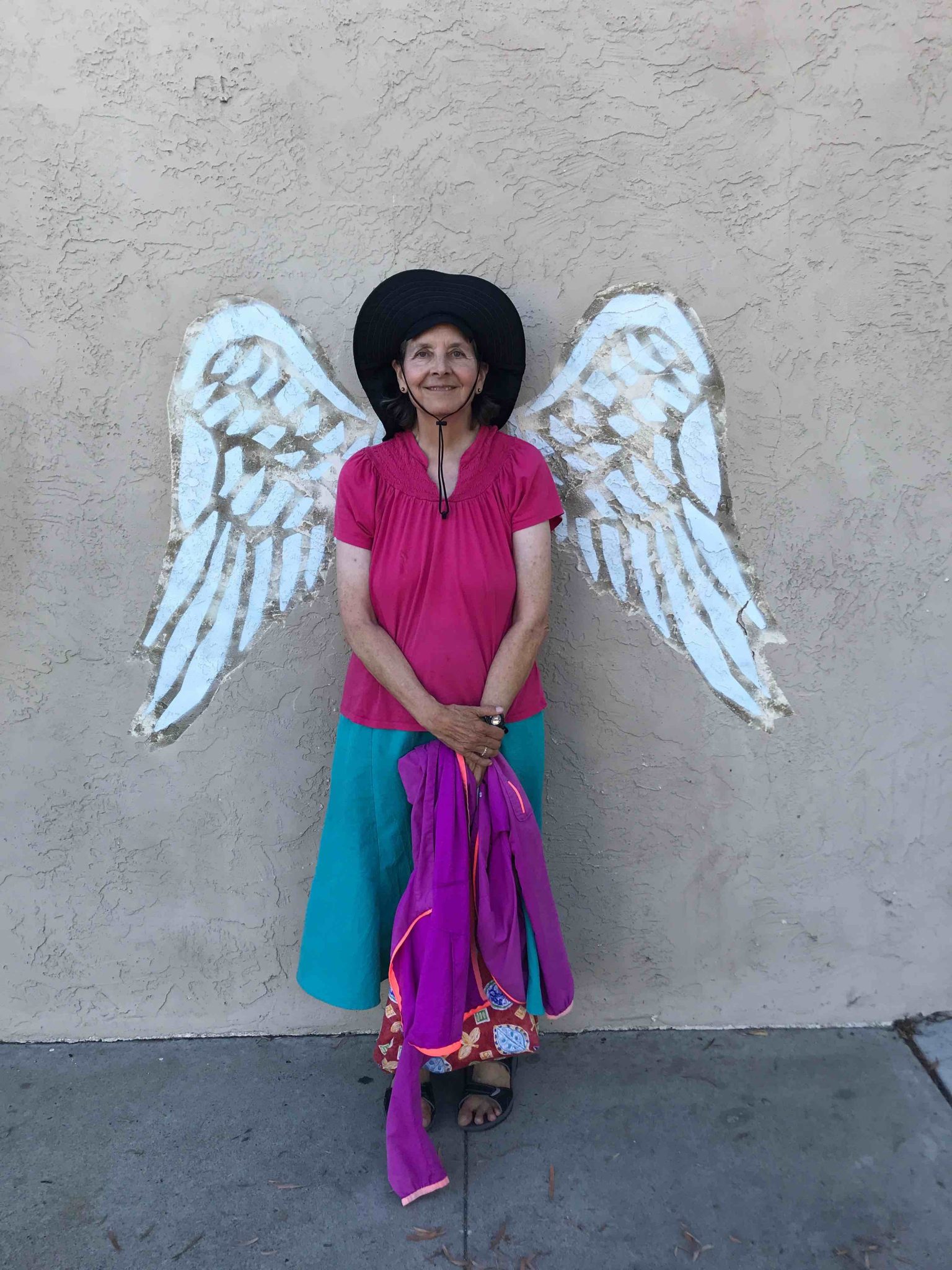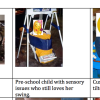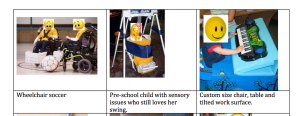Occupational Therapy
Some awesome pediatric fine motor skill ideas from an OTA student
Enjoy these three simple and fun fine motor activities for kids….
One of my former OTA students, Karina, has a FABULOUS imagination and creative streak. I was very impressed with the things she came up with. I’ve been meaning to post these for a long time.
Funny OT-related quotes
"If you can’t make fart noises, you might as well not be a pediatric OT." – former professor
"If you’re board certified in pediatrics, you know how to use a whoopee cushion." – former professor
"Embarassing moments" story told by a post-professional OTD student to the class.
Nurse: You have to rub this lube into his balls…
Jane: I don’t think I’ve touched another man’s balls
Nurse: You better get used to it…”
Jane: “…and that’s why I’m in peds now…"
Research
"It’s like when you’re doing research and you look at one website and then another and then another. And then five hours later you’re watching a video on how to feed a giraffe.” – different former professor
Safety
"Safety would be easy if it weren’t for the people." – an overheard quote given to us by professor
Stumbled across these quotes while looking for something else…had to share. 🙂
Upcoming blog posts?? Finally?
It’s been a looooong time since I’ve posted. In fact, I wrote what’s below in JUNE 2021 and it took me this long to actually post it. ::shame::
Starting in November 2016 until just recently, my life has involved a lot of death and upheaval. My grandfather, my father, my cat, and most recently my mother.
I’m starting to emerge. I’ve recently been doing some presentations to elementary school children on my children’s book, The Centipede Who Couldn’t Tie His Shoes, and the editing/journey of writing a book. I’ve also done one on mental health and energy conservation, and a few on using children’s books to increase awareness of disability.
Lately, I’ve started working on a blog post about my mom’s time in hospice and all the OT-related things I learned during my year and half of caregiving. Most specifically, things that improved her quality of life and therefore ours.
My mom passed away in January of 2020 due to progression of metastatic breast cancer, which was primarily in her bones. Luckily, she was able to pass away peacefully at home.
My non-OT journal of my mother’s journey is here:
http://caringbridgeclassic.org/ca/kathy/
Mostly this blog post is to say I still exist and I think about this blog all the time and I need to start writing again and I think my writer’s block has to do with wanting to first get out my mom-hospice post before I start writing more about other stuff. (The block isn’t that I can’t think of what to write about, it’s just that I keep avoiding writing!)
What will also help is if this blog post actually goes up as I do much better when I can post via e-mail than have to sign in. 🙂
Update: Considering it’s now November 2021 you’d think I’d have finally gotten that hospice/palliative care/death and dying blog post done….but noooo. Hopefully soon. Since as of today, fingers crossed, the post by e-mail issue is fixed.
Lava Paper: Dramatic Game Paper make learning handwriting more fun
Pediatric OTs or parents: If you’re working with a child who is highly intelligent but has poor handwriting and one of the reasons is that they are bored/don’t care about sizing rules….this “lava paper” (game paper) is for you.
The importance of validating feelings
 I haven’t posted about OT in a loong time here! But this situation arose the other day and it got me reflecting.
I haven’t posted about OT in a loong time here! But this situation arose the other day and it got me reflecting.
My friend and I were leaving a restaurant.
A white-haired woman was slowly headed towards the sidewalk in front of the restaurant. She had the panicked look of someone who is scared of falling. Another lady was holding her hand, helping steady her as they walked. A white-haired man waited at the curb for them.
As the unsteady woman reached the curb, requiring her to step up, she hesitated.
The man at the curb said to her, neutrally but with slight impatience: “It’s not a mountain.”
As I walked past, I chimed in: “It FEELS like a mountain.”
The woman instantly cried out, “YES! THANK YOU!” in a relieved tone. She felt validated/seen.
I am about to start teaching psychosocial OT/mental health to incoming Occupational Therapy Assistant (OTA) students, for the third time now, and one thing we circle back to again and again is validation of feelings of their clients.
Yes, maybe a curb is not a mountain, maybe other people have it worse, blah blah blah. But people crave validation. Especially people in pain or fear. It doesn’t mean we are agreeing with them. It just means we hear them, see them. Often, once a person feels validated, they’re then more willing to hear alternative points of view, or to move on.
The day I first introduce validation as an important component of therapeutic use of self with clients, I have them watch this brief clip from the incredible animated movie “Inside Out.”
In this sweet, sad clip, we quickly see the outcomes of invalidating versus validating feelings. Even children can understand the concept once it’s discussed using that clip as an example.
I love the concept of “therapeutic use of self” and address it in a blog post here as well: https://missawesomeness.com/therapeutic-use-of-self-in-ot
My first book is OUT!
My first children’s picture book is finally out on Amazon as of mid-June 2018! The Centipede Who Couldn’t Tie His Shoes.
So far it’s only on Amazon, but hopefully soon you’ll be able to find it in libraries and some local San Diego stores. I’m also aiming to get it in some therapy catalogs and online therapy stores. If you are interested in having a local (to you) bookstore or library carry it, please contact me on gmail (it’s just my name, karen.dobyns) and I’ll e-mail you the PDF of what’s called a “sell sheet,” which has information the store would need in order to look into it. 🙂
It’s unbelievable how much work goes into creating a book in terms of technical details, and now it’s time to focus on marketing. I had noooo idea there was so many pieces to it, but I’m learning, and it’s a fun journey. I’m hoping to inspire more OT practitioners to write and/or illustrate!
I’m just starting to get Amazon reviews – I’d love you forever if you write one, and feel free to have some actual criticism in there, I know the book is not perfect! It’s actually good to have some 4-star or even occasional (gasp) 3-star reviews, that’s more realistic than everyone saying it deserves 5-stars.
Right now Dr. Anne Zachry is hosting a book giveaway on her blog, Pediatric OT Tips, if you want to check that out.
And Tonya of Therapy Fun Zone just wrote a review on my book as well, as well as directions for an adorable jellyfish craft that uses shoe-tying skills with two different colors.
My first children’s book is coming out…
Wow, I haven’t updated my blog in over a year! Yikes! How horrible is that! The end of 2016 and most of 2017 were pretty challenging but I think I’m ready to start blogging again/cleaning up and updating my website.
For now I am just excited to say my first children’s book is coming out soon. Click the “books” tab above or go here for some information – more to come soon. https://missawesomeness.com/books/
Therapeutic use of self in OT
I am now teaching a mental health/psychosocial course to occupational therapy assistant (OTA) students at a local community college. This week we’ll be looking at the concept of “therapeutic use of self” when working with a client/consumer/patient/your preferred term here. How we can respond to behaviors in various ways, and “therapeutic use of self” is always powerful. The following memory came to mind….it took place on a locked geriatric psych ward, over 5 years ago. I was an occupational therapy student on my Level II fieldworks. I wrote up this memory back when I was a student, so here I’m just slightly modifying the original writing.
“I had a patient, an elderly man, who had expressive aphasia. For the most part, he could only seem to say a single word – a curse word. He would vary the tone of this curse word, so if he said it kindly it was a good thing. He usually used it neutrally. One day, I came across him in the hall, sitting in his wheelchair, and realized by the wetness of his lap, and mostly empty cup of ice, that he had spilled it in his lap, although he didn’t say anything.
I told him I’d get him a towel and some more water, and started to hurry off to do so. He became agitated and clearly and loudly said “WAIT! WAIT!” (which was surprising since I had really only ever heard him say his curse word), and tried to grab at me. So I stopped and retraced my few steps. I stood calmly in front of him for a minute, saying nothing, but clearly present. He just looked at me. Finally, about a minute later, when I sensed he was calmer, I said slowly and calmly, “May I get you a towel?” He nodded yes. When I got back, I said calmly, “May I get you more water?” He nodded yes. I’m proud I realized his agitation was (probably) coming from wanting some control and trouble processing, so I’m glad I did what I did, once I realized I was operating too fast for him.
I was in a rush initially because stuff like that is a big productivity-sucker – technically for stuff like that I should mention it to an aide, instead of doing it myself, because I was solely based on billable units (meaning that I’m expected to reach a certain level of “productivity” by treating clients, and anything that doesn’t count as treatment is threatening productivity and therefore how much money the hospital takes in.) But I think it’s good to do it myself anyway for many reasons, including, most importantly, ethical and empathy reasons.” (The whole productivity vs ethical actions is a can of worms in itself!!!)
Easy Ways to Teach Your Child Problem-Solving Skills
Does your child get upset easily over small and easily fixable things, like a ball rolling under a table? It may be because he doesn’t realize he has any power to fix the problem. Luckily, you can teach him to feel more empowered. I introduce to you the PSST Method!
Download the PDF of this here: The PSST! Method: Teach Your Child How to Problem Solve
Or just read on.
The PSST! Method: Teach Your Child How to Problem Solve
Children who feel confident in their problem-solving abilities can better tolerate and handle unexpected events. All children of any age can benefit from learning problem-solving skills. Adjust your language or extent of experimentation based on your child’s age/ability/tolerance level. The steps stay the same. (Ideally, use them all in order. But using any is great.)
SAMPLE PROBLEM: Young John’s ball just rolled under the couch. John scrunches up his face, ready to cry. Daddy jumps up to go grab a broom handle and solve the problem.
WAIT! John needs to learn the steps BETWEEN the problem and a successful solution.
- Pause. Just briefly. See if the child will attempt to problem-solve. If not, proceed to step two. Eventually, your child may make the attempt.
- Frame the Problem. “Wow, the ball rolled under the couch, and we can’t reach it.” You can also provide “emotion” and “help” words. “Your face is turning red and you look really frustrated. You can say, “Please help me solve this problem.”
- Play “Dumb.” Whether you instantly have a solution or not, you can pretend you’re not quite sure what to do. Crinkle up your forehead and look thoughtful. “Hmmm….”
- Think Out Loud. Most adults problem-solve in their heads. If you can role-model the problem-solving process, you’re giving him valuable insight, and showing that it’s not magic. “The ball’s is under the couch. We have to get it out somehow…maybe we can try…” With an older child, you can ask them if they have any ideas.
- See What Happens. You may know that your hand won’t fit or his arm can’t reach, but he doesn’t. When it’s feasible to experiment (not a safety hazard or massive inconvenience), try it out. He learns a lot more that way. “Let’s see if your arm is long enough. Can you lie down and reach for it?”
- Repeat Steps # 4 (Think Out Loud) and #5 (See What Happens), until problem solved. “That didn’t work because the ball’s too far away, will my hand work? …No, too big. Hmm, maybe something small but long to help us get the ball.. see if this will work…no….hmm…let’s see if we can find something…oh, let’s try a broom handle!”
- Frame the solution. “The ball rolled under the couch and we were really frustrated and we didn’t know what to do. But we tried lots of ways to solve the problem and now we have our ball back. We are great problem-solvers!”
Repeat this process regularly. As he becomes more proficient, you can take more of a back seat to the problem-solving process.
Bonus: Consider sprinkling “What If’s?” into your conversations/play time. “We solved that problem! What if the ball landed in a tree? Or this hole? Or under the bed?” Talking is great, acting it out is even better. Play a game called “Problem-Solving Superheroes” where you deliberately practice these kinds of things.
Good luck – let me know how it goes!
PS: This method may seem obvious to you – but many caregivers would benefit from the reminder.
Interested in practical adaptive equipment design?
See flyer here:
Homemade Customized Adaptive Equipment
My lovely friend Beth has been working on practical adaptive equipment – creating it at a fraction of the cost of commercial design. I copied the following text from the flyer: “I want to customize or build adaptive items for children with special needs. My dream is to have a workshop where families, teachers and designers can meet. Footrests, booster seats and supportive seats can be purchased from special needs catalogs but they are generally hundreds of dollars. I make most items out of extra strong cardboard, plastic, fabric and foam. They are inexpensive, light-weight and last a long time. I took cardboard construction classes at the Adaptive Design Workshop in New York City. The founder, Alex Truesdell, won a McArthur Award for her work. Many students who take the class are interested in starting their own workshops. It really helps to have experience building things.
What products do your kids need most? What features do you need that you can’t find? What do you want but can’t afford? I would love to hear your ideas. I’m not in business yet. I just learned that product liability insurance costs a minimum of $3500 per year. (On top of general liability insurance.) I may have to find or create a position at an existing company or organization that already serves the special needs population. Apparently, the price of insurance is stopping many of my fellow students. Connections are welcome!”
Her contact information is provided in the flyer. If you have any interest in adaptive design, or want some ideas or to know more about her work, you should definitely connect with her.










